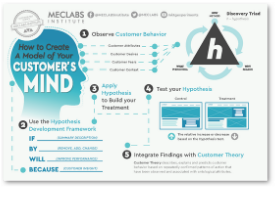I was worried that my blog last week about copyright theft (link to read it below) would spark a storm of folks posting nasty things about MarketingSherpa or my (assumed) naivete about the safety of any content on the Web.
Instead the opposite happened. Loads of you wrote (and even called) to say you had been worried about the same problem. Here’s some useful advice and hotlinks:
-> Add a formal copyright line and Terms & Conditions
At the very least, add copyright info to your published content. (See links below to copyright info for bloggers and publishers.) And don’t make the almost universal mistake of forgetting to update the year in the (c) date at the bottom of your Web pages annually.
But, don’t count on formal legal language on your site to dissuade theft. For example, I got a note from the folks at WorldWit saying their email discussion group postings appear to be routinely stolen and posted online by another site, apparently for AdSense revenue, despite WorldWit’s explicitly worded terms and conditions saying it should not be done.
-> Slim down your RSS feeds
Reader Elise Bauer of Elise.com wrote in, “Many bloggers release full-text RSS feeds, making it extremely easy for others to automatically lift their entire article. TypePad blogs, for example, release full-text RSS feeds by default, exposing their owners, often unknowingly, to bot theft.
“Who wants to spend their time trying to track down all these instances? Better to release just an excerpt in RSS. That way aggregators point back to your site, driving traffic to your site instead of stealing your content.”
-> Embed an “invisible” copyright line in articles
Reader Dave Stein of HowWinnersSell.com said he’s fed up with people stealing his articles “left and right.” He notes, “Most of the time a phone call will shake up the offender. I’ve actually made a friend or two who didn’t realize their lower-level people were stealing this content.”
He added, “One of the tricks I learned is to embed ‘(c) 2005 – Dave Stein – all rights reserved’ in white-colored font in the article. At least it’s easy to prove to an offender that they’ve pirated stuff. Plus, since I’ve keyed that string into Google Alerts, I can find out whenever someone posts it with or without permission.”
-> Ask for a hotlink
Reader Brian Cha, author of Email Marketing Resources blog, noted, “As I’m sure you already know, your page will rank higher in regards to search engine optimization when other sites link back to yours. So instead of trying to fight blog thieves, write some guidelines on how articles can be used (in regards to copyright) to help out those who legitimately want to spread the good word.”
So, perhaps we should add a note to all MarketingSherpa articles saying “If you like this article, please link to it *instead* of copying it. Thanks.”
-> Include preferred attribution lines
Reader Mary Schmidt of Schmidt & Associates notes, “Personally I’m all for people taking my content – just as long as they attribute it to me.”
So, if you are writing articles or blogs hoping to get noticed and perhaps land clients for your main line of business, then you should try putting a formal attribution and re-use line at the end of each item posted online. This might start, “Yes you may reprint this article/blog entry, as long as you include the following bit of text….”
(Of course, since MarketingSherpa is *not* a consultancy or marketing company, this would not apply to our articles. We’re solely a publishing company and our articles are our product, rather than being marketing vehicles for something else we offer. So naturally, copyright protection takes on a different urgency for us.)
-> Tell Google in writing if someone steals your copyrighted materials
As I noted last week, one reason some people steal others’ content is because they want to get Google AdSense revenue with content-rich pages without the effort of actually writing content.
To that end, many sites I’ve seen appear to be using automated bots to scrape content from other sites and then post hundreds, even thousands of pages online with AdSense listings. I’m not going to accuse any sites in particular here, suffice to say it’s a quickly increasing problem and loads of folks in the online publishing community have been noticing it.
Here’s what Barry Schnitt in Google’s PR department said in response to my query about this problem:
“Copyright violations are against our policies. We ask that the owner of the copyrighted material comply with the Digital Millennium Copyright Act (the text of which can be found at the U.S. Copyright Office Web site: http://lcWeb.loc.gov/copyright/) and other applicable intellectual property laws. In this case, this means that if we receive proper notice of infringement, we will forward that notice to the responsible Web site publisher. To file a notice of infringement with us, you must provide a written communication.”
My take on this? It’s not awfully reassuring. Google seems to want to put the policing ball in the copyright owner’s corner despite the fact that few of these stolen content sites would exist if it were not for AdSense revenues.
Plus, he didn’t comment at all on my second question, which was in essence, what about policing those sites — known in the industry as “Google Spam” — that post such short snippets of scraped content that they don’t actually break copyright law. They dance around the law and usually present no real value to the visitor.
Again, these sites are a burgeoning cottage industry that appears to be wholly funded by AdSense revenue potential.
My advice: if you are investing in an AdSense ad program, watch your metrics very carefully (separately from your AdWords ROI). Also consider the brand image implications of your ad showing up on automated bot sites. Do you want to be visibly sponsoring cruddy Web pages?
Until such time as Google decides to police more rigorously the sites ads appear on, buyer beware.
-> Five useful hotlinks about copyright and blogging:
#1. US copyright law explained in fairly clear English for bloggers with common questions (Thanks to reader Alan Herrell who pointed out this link in his Raving Lunacy blog) http://www.eff.org/bloggers/lg/faq-ip.php
#2. Official copyright info site from US Federal Government http://www.copyright.gov
#3. Copyscape — Quickly see if any Web page tracked by Google search is copying content from a particular page of your site or blog: http://www.copyscape.com
#4. Example of what appears to be an automated bot site that collects snippets of content from blogs and sites without adding any additional value/commentary, for the sole purpose of Google AdSense revenue (thanks to reader Tom Hespos of Underscore Marketing for sending in this link): http://www.ad-agency.your-information-source.com/blog/
#5. Last week’s column on Blog Copyright Theft http://www.marketingsherpa.com/sample.cfm?contentID=3032









